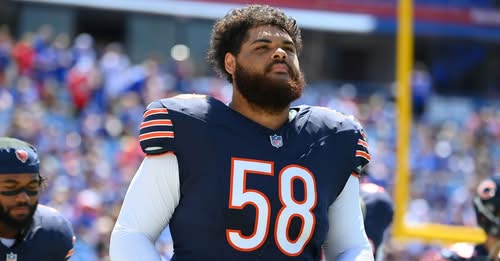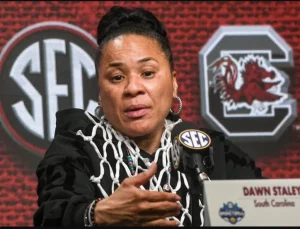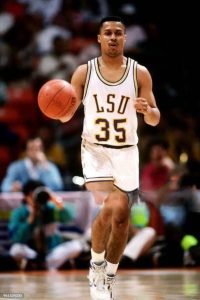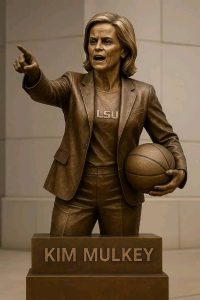
After a disastrous 2024 campaign that saw the Chicago Bears’ offensive line falter under pressure and fail to protect their young quarterback, the front office had no choice but to act decisively. General manager Ryan Poles, with new offensive coordinator Ben Johnson by his side, approached the offseason with a singular mission: fix the offensive line, no matter the cost.
The results were dramatic.
Chicago didn’t just tinker around the edges. They aggressively attacked their weakest unit with urgency and clarity. The Bears invested heavily in both free agency and the NFL Draft to bring in players with the power, athleticism, and intelligence to transform their offensive front into a strength. Anchored by high-upside rookies and key veteran additions, the 2025 version of the Bears offensive line is night-and-day compared to last season’s group. And it needed to be.
Poles and Johnson knew that if they wanted to give their offense a chance to thrive—especially with a developing quarterback and a promising skill position group—it all had to start up front. That philosophy guided every move they made. Gone are the players who struggled to hold their blocks, missed assignments, or lacked the durability to stay on the field. In their place is a new-look unit that’s more cohesive, technically sound, and built with versatility in mind.
The early returns from offseason workouts and mini-camps have been positive. There’s optimism surrounding the chemistry being built in the trenches. Coaches are excited, players are buying in, and the overall tone has shifted. Instead of questions and excuses, there are answers and accountability. It’s exactly what Bears fans have been waiting for. But while the short-term improvements are clear, questions remain about the long-term outlook of the offensive line.
Bill Zimmerman, a veteran analyst who has closely followed the Bears for over a decade, recently broke down the unit’s future prospects. His take? While there is plenty to like, the line’s sustainability will depend on a few critical factors.
First and foremost is the development of the young linemen. The Bears used premium draft capital on players they believe can anchor the unit for years to come. If those players hit their ceiling, Chicago could be looking at a top-10 line in the NFL for the foreseeable future. However, as with any young talent, there’s always a risk. Injuries, regression, or even coaching changes can derail what seems like a sure thing. Zimmerman points to other franchises who thought they solved their O-line issues only to see them reappear a year or two later. The NFL is unforgiving, and one or two miscalculations can turn a strength into a liability.
Another point Zimmerman emphasizes is continuity. One of the most underrated aspects of elite offensive line play is stability. Lines that remain together year after year tend to perform at a higher level. The Bears’ new group has yet to take a regular-season snap together. While the potential is there, chemistry on the line takes time to develop. It’s not just about physical tools—it’s about communication, trust, and instinct. If Chicago’s line can stay healthy and build that bond over time, the future is bright. But if injuries or contract disputes disrupt that process, it could be back to square one.
Then there’s the financial angle. Ryan Poles made savvy moves this offseason, balancing short-term needs with long-term flexibility. But at some point, the Bears will need to decide which linemen to commit to long-term. It’s unlikely they can keep everyone, especially if several young players develop into stars. Will they pay to keep the band together, or will they have to make tough decisions to prioritize other areas of the roster? The answer to that question could determine whether the offensive line remains a strength or becomes another cycle of patchwork solutions.
Zimmerman also notes the importance of coaching. Ben Johnson is known for his offensive creativity, but his ability to work with line coaches and develop consistent blocking schemes will be key. The best offensive lines don’t just have talent—they have a system that maximizes it. Johnson must find ways to protect his quarterback with quick decisions, motion, and play-action. Scheme can make a good line look great, and a great line look dominant. If Johnson and his staff can stay one step ahead, the Bears will benefit.
Looking ahead, the 2025 season could be the turning point. If the line performs as expected, Chicago may finally have the infrastructure needed to contend in the NFC. The quarterback’s job gets easier. The run game becomes more consistent. The offense finds rhythm. But if things don’t go according to plan, the Bears will once again find themselves asking what went wrong in the trenches.
One name to watch is the rookie left tackle, a mauler with elite traits but limited experience against NFL-caliber edge rushers. His progress will be crucial. If he develops quickly, it allows the Bears to lock down the most important position on the line. If he struggles, the ripple effects could be significant. The Bears are counting on his upside, and early signs suggest he’s up for the challenge. But fans will have to wait until the real games begin to know for sure.
On the right side, a newly acquired veteran brings leadership and technique to the table. His presence alone raises the floor of the unit. But age and durability are concerns. Chicago will need to manage his workload and ensure there’s a succession plan in place. Depth is better than it’s been in years, but the NFL season is long, and attrition is inevitable.
Interior play, always the unsung hero of offensive success, is another area of focus. The Bears believe they have a pair of guards who can become Pro Bowl-caliber players. If they live up to that billing, it opens up everything. Protection in the pocket improves, interior runs become more efficient, and the entire offense flows better. The center position, too, has been stabilized, giving the quarterback a reliable communicator and snapper to lean on.
Still, the NFL landscape is ever-changing. Defensive lines get better, faster, and more creative every year. What works in 2025 might not hold up in 2026. That’s why the Bears need to think two steps ahead. Drafting with depth in mind, developing practice squad talent, and ensuring coaching consistency will all be critical in maintaining what they’ve built.
In the end, the Bears deserve credit for confronting their biggest weakness head-on. Ryan Poles showed boldness and vision. Ben Johnson brought a fresh approach. Together, they’ve given Chicago a chance to build something lasting. But only time will tell if this foundation can support a true contender.
Zimmerman’s analysis provides both hope and a cautionary tale. The Bears offensive line has been rebuilt, yes. But whether it’s truly ready to withstand the test of time will depend on more than just talent. It will require health, cohesion, strategy, and perhaps most of all, patience.
For now, Bears fans can take solace in knowing their team took the issue seriously. The line looks better. The plan looks sound. And the future? Well, it just might be brighter than it’s been in a very long time.





